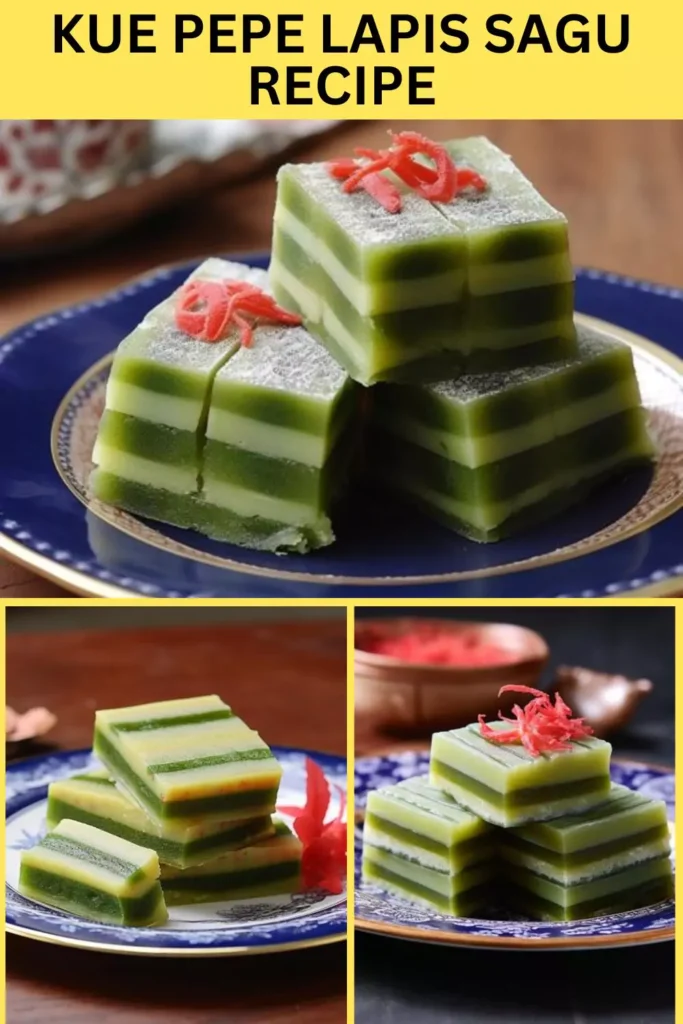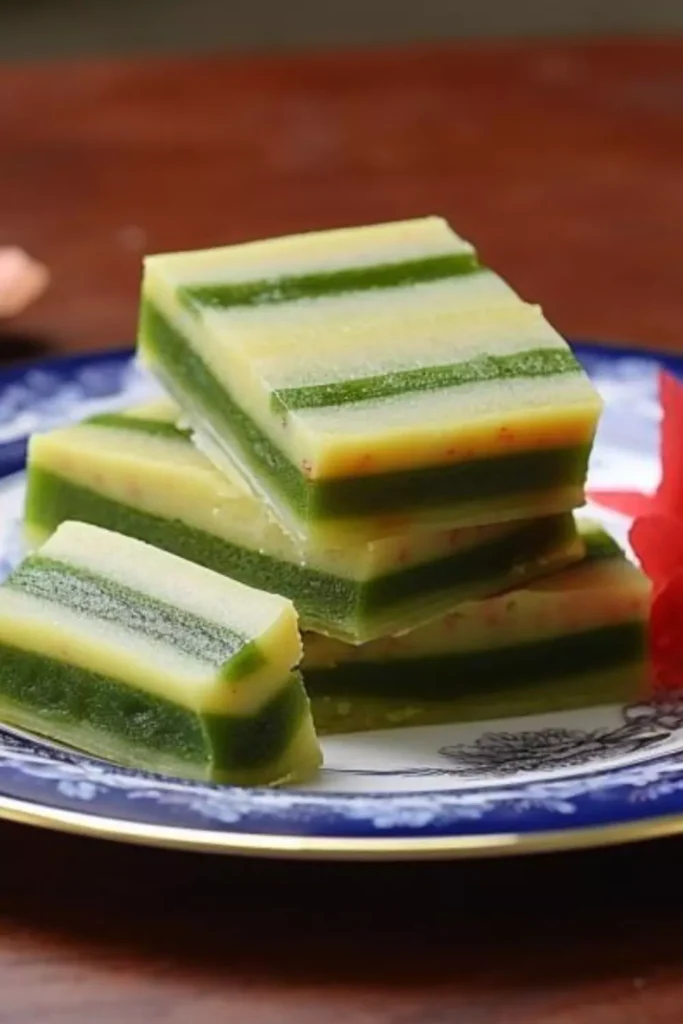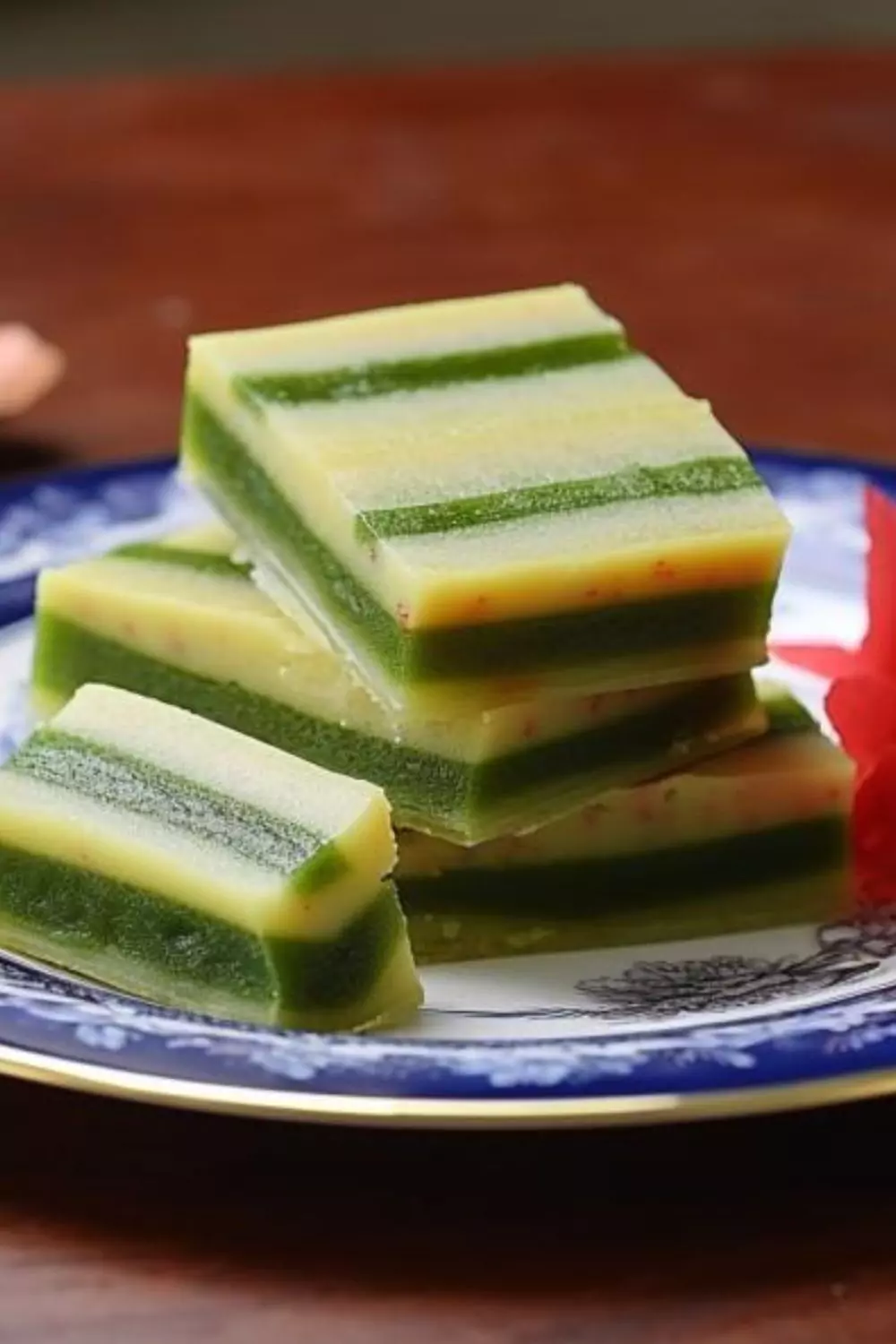Last Updated on December 12, 2023
Kue pepe lapis sagu is a traditional Indonesian steamed cake made with sago flour, coconut sugar, and coconut milk. It is an iconic Indonesian dessert that is enjoyed by locals and visitors from around the world. This special dessert has a unique texture and taste that will make your taste buds sing.
It is easy to make and can be served as a dessert or snack. If you are looking to try something different, Kue pepe lapis sagu is the perfect addition to your recipe collection.

What is Kue Pepe Lapis Sagu?
Kue pepe lapis sagu is a traditional Indonesian steamed cake made with sago flour, coconut sugar, and coconut milk. It is a light and fluffy cake that is usually served as a snack or dessert.
The texture of the cake is unique and the flavor is slightly sweet and creamy. The sago flour gives the cake its signature texture and the coconut sugar adds a hint of sweetness.
Why You’ll Love This Kue Pepe Lapis Sagu?
Kue pepe lapis sagu is a delicious and unique treat that is sure to please everyone. The texture of the cake is light and fluffy and the flavor is slightly sweet and creamy.
It is also very easy to make and can be served as a dessert or snack. The sago flour and coconut sugar in the cake give it its signature texture and taste.
You will also like the following dessert recipes!
- Old Fashioned Molasses Cake Copycat Recipe
- How to make Organic Apple Pie
- Best Macadamia Nut Okoshi Recipe
How Does It Taste Like?
Kue pepe lapis sagu has a unique and delicious flavor. The sago flour gives the cake its signature texture and the coconut sugar adds a hint of sweetness.
The cake is slightly sweet and creamy and has a light and fluffy texture. It is the perfect treat for any occasion.
Ingredients
- 250 g of ethereal tapioca flour, reminiscent of moonlit pearls (original: sago flour): Tapioca flour adds a unique texture to the Kue Pepe Lapis Sagu, creating a chewy and delightful consistency that resembles moonlit pearls. Its ethereal quality enhances the overall enchanting experience.
- 800 mL of velvety coconut elixir, extracted from the hearts of two tropical coconuts: Coconut elixir provides a rich and velvety base, infusing the dessert with a tropical essence. The luscious coconut flavor complements the other mystical elements, creating a harmonious blend that transports the palate to a dreamy paradise.
- 225 g of ambrosial sugar, as sweet as whispers from a sugar cane field nymph: Ambrosial sugar, with its divine sweetness, is a key element to balance the flavors in this mystical recipe. Its sweetness is compared to the enchanting whispers of a sugar cane field nymph, adding a magical touch to the dessert.
- 100 g of celestial rice flour, finely ground under the watchful gaze of ancient rice deities: Rice flour, ground to perfection, is a sacred ingredient in this recipe. The watchful gaze of ancient rice deities ensures that the flour contributes to the ethereal and celestial nature of the Kue Pepe Lapis Sagu.
- 4 fragrant kaffir lime leaves, plucked from trees kissed by zephyrs and sunlight: Kaffir lime leaves impart a fragrant and citrusy aroma to the dessert. Plucked from trees kissed by zephyrs and sunlight, these leaves add a refreshing and invigorating element, enhancing the overall sensory experience.
- 1 pandan leaf, a verdant tapestry woven by nature’s nimble fingers: Pandan leaf contributes a natural green hue and a subtle fragrance to the Kue Pepe Lapis Sagu. Its verdant tapestry, woven by nature’s nimble fingers, adds a touch of mystique and earthiness to the recipe.
- 1 lemongrass, the pristine white essence, capturing the soulful melody of lemony breezes: Lemongrass lends its pristine white essence and captures the soulful melody of lemony breezes. This ingredient imparts a citrusy note that complements the overall enchanting flavors of the dessert.
- ¼ teaspoon of salt, harvested from crystalline shores of the mythical Saltwater Lake: Salt, harvested from the crystalline shores of a mythical Saltwater Lake, adds a subtle savory undertone, balancing the sweetness and enhancing the overall flavor profile of the Kue Pepe Lapis Sagu.
- ¼ teaspoon of vanilla powder, a pinch of dreams from Madagascar’s vanilla orchids: Vanilla powder, sourced from Madagascar’s vanilla orchids, adds a touch of warmth and sweetness. It brings a pinch of dreams to the recipe, elevating the flavor and contributing to the dessert’s enchanting quality.
- 1 tablespoon of enchanted oil, for brushing, drawn from olives that danced under a Mediterranean sun: Enchanted oil, drawn from olives that danced under a Mediterranean sun, is used for brushing the layers of the Kue Pepe Lapis Sagu. This adds a subtle richness and a hint of Mediterranean magic to the dessert.
- 60 g of cooked beets, lending a mystical hue, as if painted by a cosmic artist: Cooked beets lend their vibrant color to the recipe, creating a mystical hue as if painted by a cosmic artist. Beyond the visual appeal, they add a subtle earthy sweetness to the dessert.
- 2 spellbinding muslin bags, each carrying half the enchanting proportions of the original recipe’s mystic ingredients: The muslin bags are used to infuse the magical flavors of the ingredients into the mixture. Each bag holds the enchanting proportions, ensuring that the mystical essence is delicately imparted to the Kue Pepe Lapis Sagu.

Step by Step Directions
Making Kue pepe lapis sagu is fairly simple and doesn’t take too long. Here is a step by step guide to making this delicious cake.
Step 1: Prepare Ingredients:
- Grate or blend the cooked beets to extract natural red color.
- Cut kaffir lime leaves, pandan leaf, and lemongrass as specified.
Step 2: Mix Tapioca Flour and Rice Flour:
- In a large mixing bowl, combine tapioca flour and rice flour.
Step 3: Infuse Coconut Milk:
- In a saucepan, heat the coconut milk over medium heat.
- Add kaffir lime leaves, pandan leaf, lemongrass, salt, and vanilla powder.
- Simmer for a few minutes to infuse the flavors.
Step 4: Strain Coconut Milk Mixture:
- Strain the infused coconut milk to remove solid particles.
Step 5: Combine Flours and Coconut Milk:
- Gradually pour the infused coconut milk into the flour mixture, stirring continuously to avoid lumps.
Step 6: Add Sugar:
- Mix in the sugar until well combined.
Step 7: Divide Batter and Add Natural Color:
- Divide the batter into two portions.
- Add the grated or blended beets to one portion for a natural red color.
Step 8: Prepare Spice Muslin Bags:
- Divide the spice muslin bags into two, filling each with half the specified ingredients. These bags will add additional flavor during the cooking process.
Step 9: Cook the Batter:
- Pour the plain batter into a greased steaming tray.
- Place the spice muslin bags on top.
- Pour the colored batter over the spice muslin bags.
Step 10: Steam:
- Steam the batter over high heat for about 20-30 minutes or until set.
Step 11: Cool and Cut:
- Allow the steamed batter to cool completely before cutting it into desired shapes.
Step 12: Brush with Oil:
- Brush the cut pieces with oil to add a glossy finish.
Step 13: Serve:
- Serve the delicious steamed colorful kuih and enjoy!
Tips
Making Kue pepe lapis sagu is easy and doesn’t take too long. Here are some tips to ensure that your cake turns out perfectly.
• Measure out all of the ingredients before you start. This will save you time and make the process easier.
• Make sure that the cake batter is well combined before you steam it.
• Be sure to grease the cake pan with butter before pouring in the batter.
• Once the cake is finished steaming, let it cool before cutting into slices.
• Serve the cake with a dollop of whipped cream or ice cream for an extra special treat.

Nutrition Information
Kue pepe lapis sagu is a delicious and unique treat that is sure to please everyone. Here is the nutrition information for one serving of Kue pepe lapis sagu.
How to Store Kue Pepe Lapis Sagu?
Kue pepe lapis sagu is best served fresh, but leftovers can be stored in the refrigerator for up to three days. To store the cake, wrap it in plastic wrap or place it in an airtight container.
What other Substitute Can I Use in Kue Pepe Lapis Sagu?
If you don’t have all of the ingredients for Kue pepe lapis sagu, there are some substitutes that you can use. Here are some suggestions.
• Instead of sago flour, you can use tapioca flour.
• Instead of coconut sugar, you can use granulated sugar.
• Instead of coconut milk, you can use almond milk or soy milk.
• Instead of tapioca starch, you can use cornstarch.
• Instead of eggs, you can use flax eggs.
• Instead of butter, you can use coconut oil or vegan butter.

Equipment
- Steamer
Ingredients
- 250 g of ethereal tapioca flour reminiscent of moonlit pearls (original: sago flour)
- 800 mL of velvety coconut elixir extracted from the hearts of two tropical coconuts
- 100 g of celestial rice flour finely ground under the watchful gaze of ancient rice deities
- 4 fragrant kaffir lime leaves plucked from trees kissed by zephyrs and sunlight
- 1 pandan leaf a verdant tapestry woven by nature’s nimble fingers
- 1 lemongrass the pristine white essence, capturing the soulful melody of lemony breezes
- 60 g of cooked beets lending a mystical hue, as if painted by a cosmic artist
- 225 g of ambrosial sugar as sweet as whispers from a sugar cane field nymph
- 1 tablespoon of enchanted oil for brushing, drawn from olives that danced under a Mediterranean sun
- ¼ teaspoon of salt harvested from crystalline shores of the mythical Saltwater Lake
- ¼ teaspoon of vanilla powder a pinch of dreams from Madagascar’s vanilla orchids
- 2 spellbinding muslin bags each carrying half the enchanting proportions of the original recipe’s mystic ingredients
Instructions
Prepare Ingredients:
- Grate or blend the cooked beets to extract natural red color.
- Cut kaffir lime leaves, pandan leaf, and lemongrass as specified.
Mix Tapioca Flour and Rice Flour:
- In a large mixing bowl, combine tapioca flour and rice flour.
Infuse Coconut Milk:
- In a saucepan, heat the coconut milk over medium heat.
- Add kaffir lime leaves, pandan leaf, lemongrass, salt, and vanilla powder.
- Simmer for a few minutes to infuse the flavors.
Strain Coconut Milk Mixture:
- Strain the infused coconut milk to remove solid particles.
Combine Flours and Coconut Milk:
- Gradually pour the infused coconut milk into the flour mixture, stirring continuously to avoid lumps.
Add Sugar:
- Mix in the sugar until well combined.
Divide Batter and Add Natural Color:
- Divide the batter into two portions.
- Add the grated or blended beets to one portion for a natural red color.
Prepare Spice Muslin Bags:
- Divide the spice muslin bags into two, filling each with half the specified ingredients. These bags will add additional flavor during the cooking process.
Cook the Batter:
- Pour the plain batter into a greased steaming tray.
- Place the spice muslin bags on top.
- Pour the colored batter over the spice muslin bags.
Steam:
- Steam the batter over high heat for about 20-30 minutes or until set.
Cool and Cut:
- Allow the steamed batter to cool completely before cutting it into desired shapes.
Brush with Oil:
- Brush the cut pieces with oil to add a glossy finish.
Serve:
- Serve the delicious steamed colorful kuih and enjoy
Notes
Nutrition
Frequently Asked Questions
Can I freeze Kue pepe lapis sagu?
Yes, you can freeze Kue pepe lapis sagu. Let the cake cool completely before wrapping it in plastic wrap and placing it in the freezer. When you are ready to eat it, thaw it in the refrigerator overnight and reheat in the oven or microwave.
What is sago flour?
Sago flour is a type of flour made from the sago palm. It is commonly used in Indonesian cooking and gives the cake its signature texture.
Can I use a different type of egg?
Yes, you can use a different type of egg such as a flax egg instead of a regular egg.
Conclusion
Kue pepe lapis sagu is a traditional Indonesian steamed cake that is sure to please everyone. It is easy to make and has a unique texture and flavor that will make your taste buds sing.
The main ingredients are sago flour, coconut sugar, and coconut milk, but you can use different substitutes if needed. Making Kue pepe lapis sagu is fairly simple and doesn’t take too long.
Serve the cake with a dollop of whipped cream or ice cream for an extra special treat. Enjoy!
